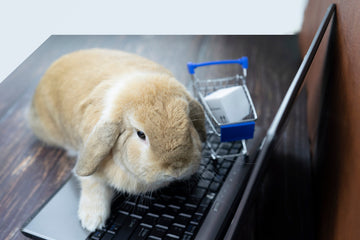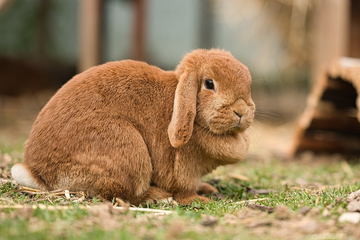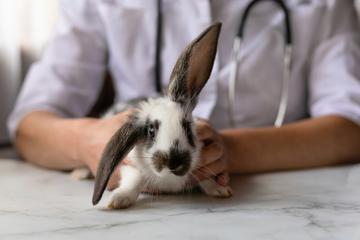Your Guide to the Best Rabbit Habitat Setup
When it comes to keeping your rabbit happy and healthy, their living environment plays a vital role. A well-thought-out setup isn't just about functionality—it's also about creating a safe, comfortable, and enriching space your rabbit can call home.
Click Here For a Guide to Creating the Ideal Litter Box.

A well-designed habitat can improve your rabbit's overall quality of life. It keeps them mentally stimulated, physically active, and emotionally content. If you're setting up or upgrading a rabbit habitat, there are several key factors to remember.
The Importance of Space
Rabbits are highly active animals. They need plenty of room to hop, stretch, and explore. Small cages might seem convenient, but they can be restrictive and lead to boredom or health issues. The recommended space for a pair of rabbits is at least 10 feet by 6 feet, with enough height for them to stand upright on their hind legs without their ears touching the top.
This generous amount of space allows rabbits to perform natural movements like sprinting and jumping. Such activities are essential for their physical health and help reduce the risk of obesity. If possible, consider exceeding these space recommendations. A larger area means your rabbits will have more opportunities to thrive.
Indoors vs. Outdoors
Rabbits can live happily indoors or outdoors, but each setup has unique requirements. Indoor setups keep your rabbits close to the family, protecting them from predators and extreme weather. However, indoor areas need to be "bunny-proofed." This means covering electrical cords, keeping plants out of reach, and removing small objects they might chew or swallow.
Outdoor habitats, on the other hand, give your rabbits access to natural sunlight and fresh air. To keep them safe, build a secure, weatherproof shelter. A sturdy design raised off the ground helps protect your rabbits from predators and harsh weather. Always include shaded areas to protect your rabbits from overheating in warmer months, whether indoors or outdoors.
Best Rabbit Habitat Setup
The best rabbit habitat setup combines safety, comfort, and enrichment. Start with a spacious and well-ventilated shelter. This could be a hutch, shed, or indoor play area. Your rabbit's living quarters should allow them to lie down, stretch, and move freely. Make sure the shelter is easy to clean and has separate areas for food, water, and a litter tray.

If your rabbits live outdoors, additional considerations are necessary. Weatherproof the shelter for winter, and ensure it's insulated to maintain a comfortable temperature. For indoor rabbits, designate a quiet area where they can retreat when they need a break from household noise.
Exercise Area
Rabbits are most active at dawn and dusk, so they need access to an exercise area during these times. Ideally, this space should be directly connected to their shelter, allowing them to move freely. For indoor rabbits, a bunny-proofed room or playpen works well. A secure, enclosed garden area can serve as an excellent exercise space for outdoor rabbits.
Make this area fun and engaging by adding ramps, tunnels, and hiding spots. Enrichment tools like these encourage exploration and keep your rabbits mentally stimulated. Be sure the space is free from hazards like sharp objects, toxic plants, or anything that might harm your rabbit.
Social Interaction
Rabbits are incredibly social animals. Keeping a single rabbit can lead to loneliness, so having at least two bonded rabbits is better. Neutering or spaying is recommended to prevent unwanted litters and to reduce the risk of aggressive behavior. Bonded rabbits tend to display playful and loving behaviors that are delightful to watch.
Companionship not only improves your rabbit's mental health but also enhances their overall happiness. Be sure to give them plenty of space to interact and provide multiple hiding spots where they can enjoy some quiet time when needed.
Enrichment
Rabbits are intelligent and curious, so they need mental stimulation to stay happy. Boredom can lead to destructive behaviors, so keep things interesting with toys, tunnels, and digging boxes. Rotating toys regularly will keep your rabbits engaged and prevent them from losing interest.
Encourage natural behaviors by providing opportunities for digging and chewing. For example, a large litter box filled with soil or a sandbox can be a safe digging area. Additionally, chew toys made from untreated wood or hay blocks are great options for keeping their teeth healthy.
Bedding and Litter
Comfortable, clean bedding is essential for your rabbit's well-being. Start with a layer of newspaper or wood-based litter pellets, then top it with soft straw or hay. This setup keeps your rabbits warm and provides a cozy space for them to relax. Bedding should be replaced regularly to maintain a hygienic environment.
Litter training your rabbit is relatively easy. Place a litter tray in their preferred toileting area and fill it with rabbit-safe litter. Cleaning the litter tray daily and changing the bedding weekly will help keep the habitat fresh and odor-free.

Water and Food
Access to clean water is crucial for your rabbit's health. A water bowl is better than a bottle because it's more natural for rabbits to drink from and easier to clean. For households with multiple rabbits, place several water bowls throughout the habitat to ensure everyone stays hydrated.
Rabbits need a diet primarily made of fresh hay. Supplement their diet with leafy greens, vegetables, and a small amount of high-quality pellets. Check daily for uneaten fresh food and remove it to prevent spoilage or pests. For more information about rabbit nutrition, check out this external guide on rabbit diets.
Conclusion
Creating the best rabbit habitat setup is more than just providing a place to sleep. It's about designing a space where your rabbit can thrive physically, mentally, and emotionally. Prioritize space, social interaction, and enrichment when planning your rabbit's environment.
Whether you choose an indoor or outdoor setup, focus on safety and comfort. With a little effort and creativity, you can create a home where your bunny will live a happy and healthy life.

Rabbit Hygiene: Essential Care Tips

Best Spot: Where Can I Buy Rabbit Food

The Rabbit Skeleton System Explained










